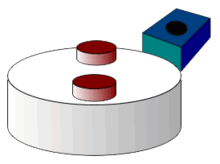
Back Датчик на Хол Bulgarian Sensor d'efecte Hall Catalan Hallova sonda Czech Hall-Sensor German Αισθητήρας Χολ Greek Sensor de efecto Hall Spanish Halli tajur Estonian Hall efektuko sentsore Basque حسگر اثر هال Persian Capteur à effet Hall French
This article may require copy editing for grammar, style, cohesion, tone, or spelling. (February 2024) |

A Hall effect sensor (also known as a Hall sensor or Hall probe) is any sensor incorporating one or more Hall elements, each of which produces a voltage proportional to one axial component of the magnetic field vector B using the Hall effect (named for physicist Edwin Hall).
Hall sensors are used for proximity sensing, positioning, speed detection, and current sensing applications[1] and are common in industrial and consumer applications. Hundreds of millions of Hall sensor integrated circuits (ICs) are sold each year[2] by ~50 manufacturers, with the global market around a billion dollars.[3]
- ^ Ramsden, Edward (2006). Hall-effect sensors: theory and applications (2, illustrated ed.). Elsevier. ISBN 978-0-7506-7934-3.
- ^ "How the Hall Effect Still Reverberates - IEEE Spectrum". spectrum.ieee.org. Retrieved 2023-12-28.
- ^ "Global Industry Analysts: Global Hall-Effect Current Sensors Market to Reach $1.3 Billion by 2026". www.prnewswire.com. 2021-07-01. Retrieved 2023-12-28.
© MMXXIII Rich X Search. We shall prevail. All rights reserved. Rich X Search